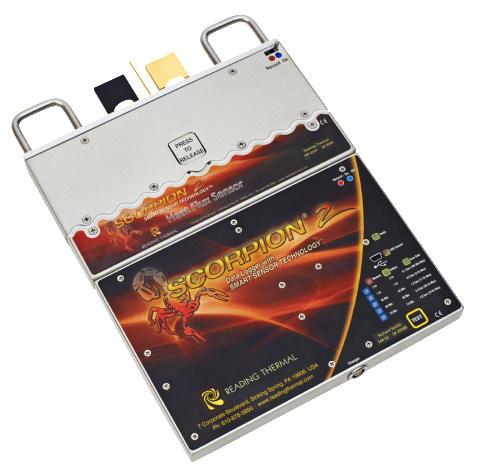High-rate baking can provide your bakery products with golden, crisper crusts. If they aren’t turning out as expected, troubleshooting is the answer. Reading Thermal’s state-of-the-art SCORPION® 2 Profiling System can help you make adjustments to achieve superior products.
Reading Thermal, headquartered in Sinking Spring, PA, has been focused on measuring and understanding the commercial baking process for more than 25 years.
Our SCORPION® 2 Profiling System enables you to monitor in-process conditions and get the information you need to correct any issue with your products and maintain optimum process control. This powerful diagnostic tool has become an industry standard for understanding and improving your proofing, baking, cooling, and freezing processes.
Why Heat Flux Profiling Is Important
The characteristics of specific products are defined by the amount and type of heat applied to them during the baking process. The differences explain why one oven bakes differently than another. And analyzing and controlling these differences is critical to understanding how the finished characteristics of a product will be affected.
Bakers often use heat flux profiles when trying to produce the same product on two different lines or when transferring products from one line to another. When the heat flux profiles match, the two lines produce the same product.
We designed the SCORPION® 2 Heat Flux Sensor to measure radiant and convective heat fluxes at product level and show the results in Btu/hr·ft2 or W/m2. The heat is absorbed by the band, which serves as the conduction mechanism. The sensor travels through the oven under full load, producing a detailed profile of heat flux components that the product experienced.
Why Temperature Profiling Is Important
The characteristics of your baked goods are determined by the heat applied to them while baking, and every oven bakes differently. Product quality will depend upon oven performance.
You may understand every other step in your manufacturing operation, but do you know what happens inside your oven?
Product level temperature inside your oven can make the difference between the highest quality products and wasteful, under-baked, or burnt products. The processes of fermentation, product swelling, moisture evaporation, flavor development, and surface coloring are also time and temperature-dependent. For example:
- With too little heat, finished crusts may be dry or brittle.
- With too little heat, finished products may be too light in color.
- With too little heat, the product’s structure may be too dense.
- Too much heat can cause the bottoms of the loaves to burn before the crusts brown correctly.
- Too much heat causes moisture to evaporate too quickly and the dough to rise unevenly.
Pluggable Temperature Sensors
The SCORPION® 2 Temperature Sensor Array is connected to the SCORPION® 2 Data Logger and moves through the oven with the product, producing a precise picture of temperature. It measures temperature at the product level, in fixed positions across the conveyor, and denotes what your product experiences over time. Different types of pluggable sensors are available. One is designed for solid or tight mesh conveyors and one for open mesh conveyors.
Use Reading Thermal profiling systems for troubleshooting to gain information you can use to make reliable data-based decisions about your processes and products. Contact us online, or call (610) 678-5890 Ext. 2 to explore our line of innovative products.

